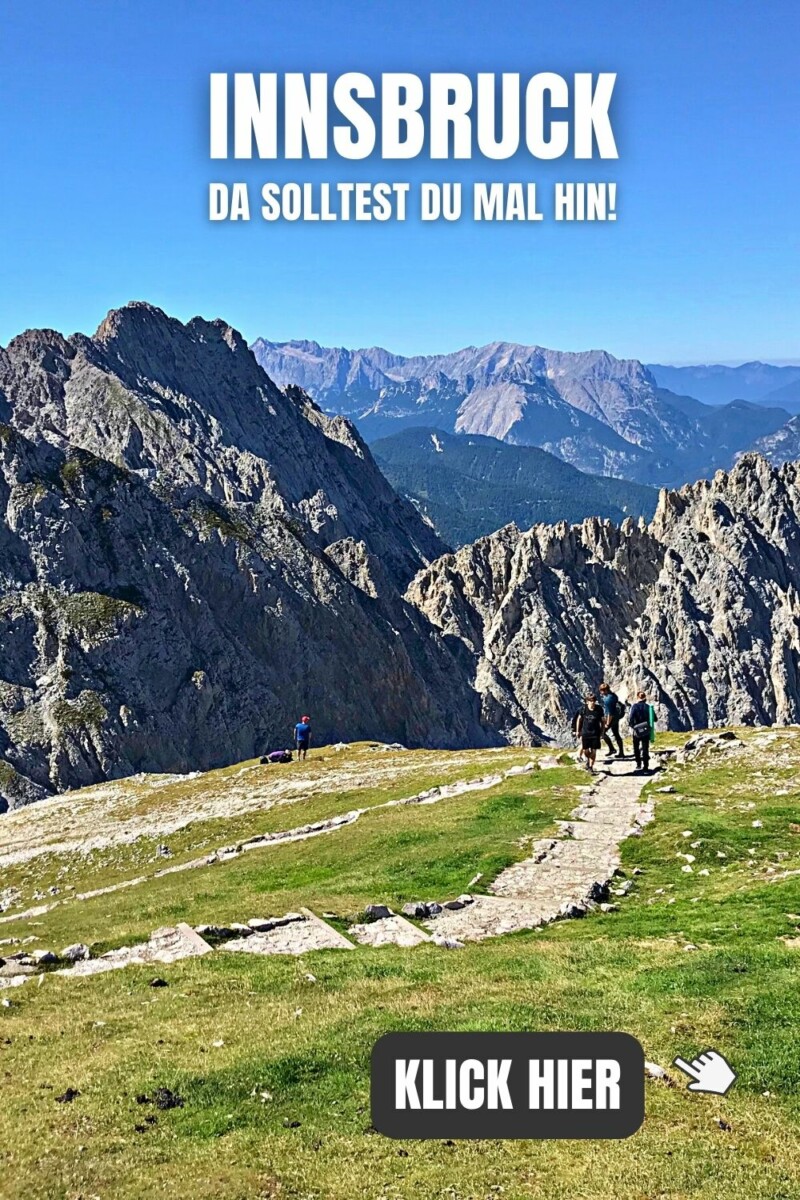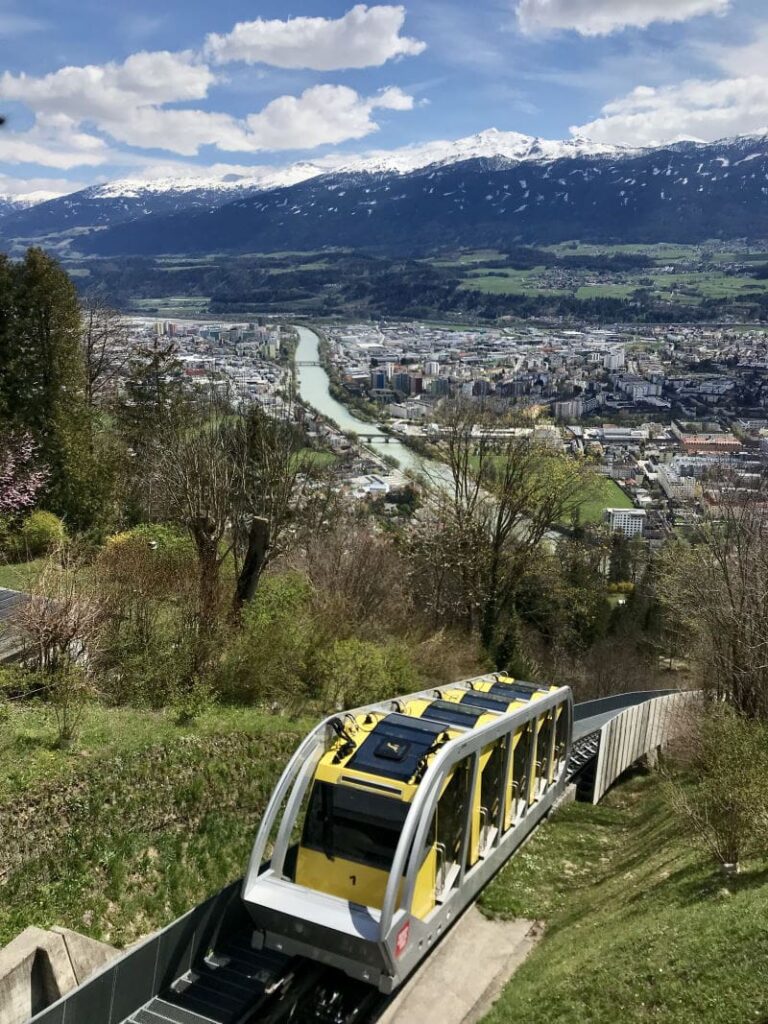
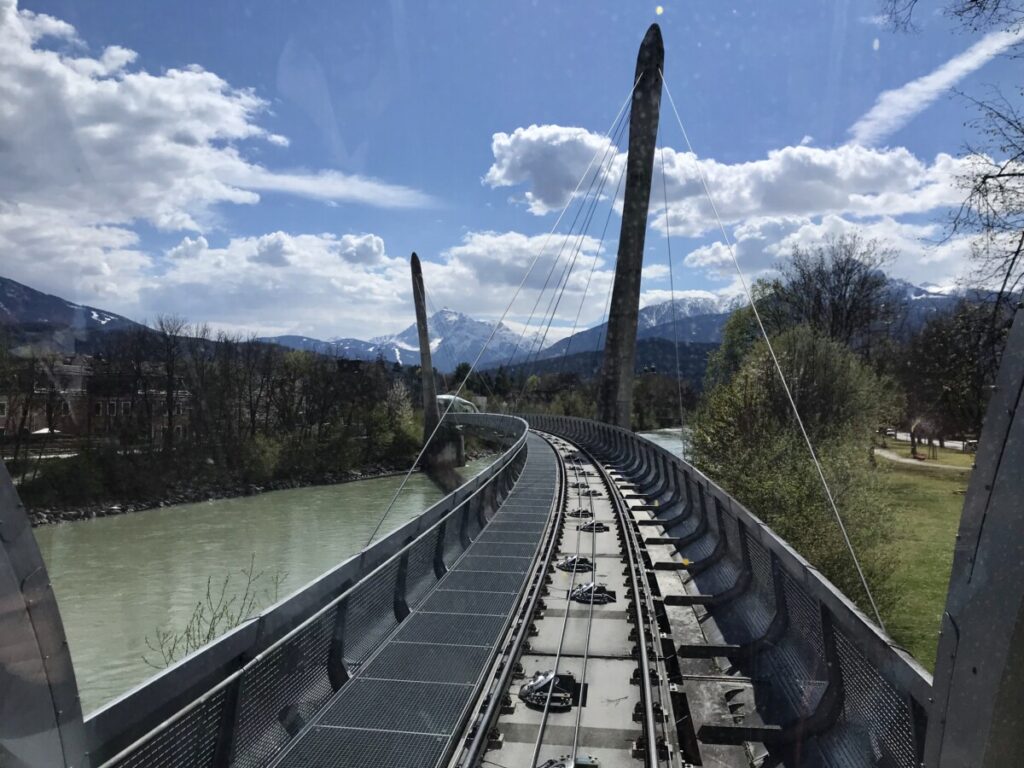
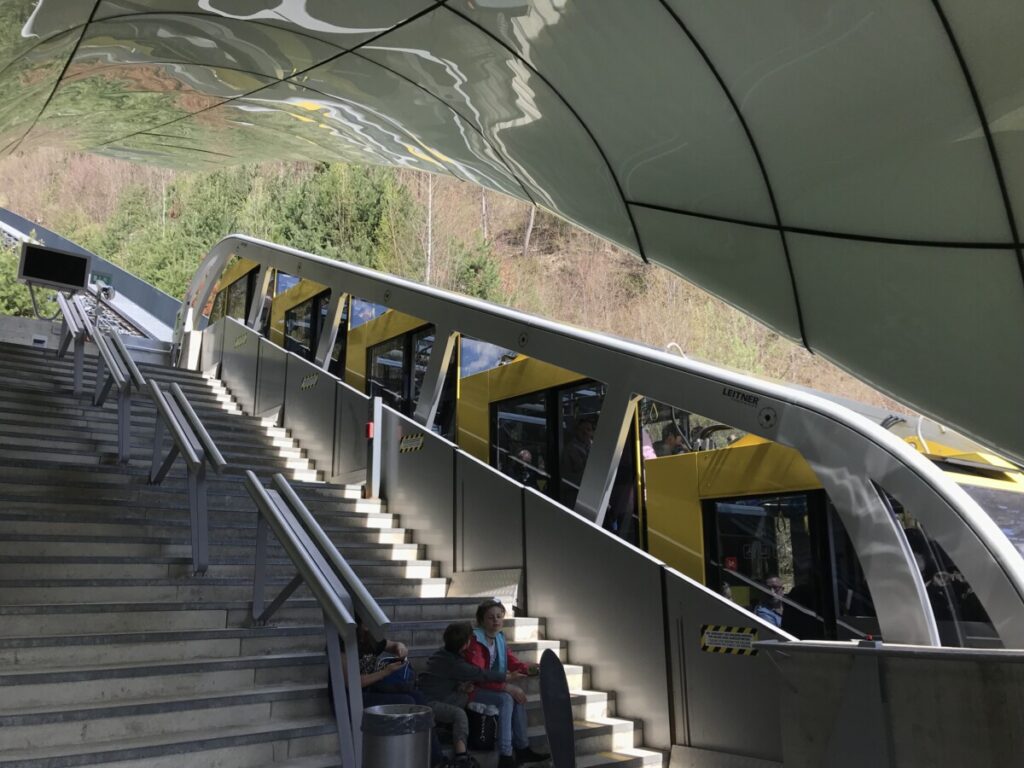
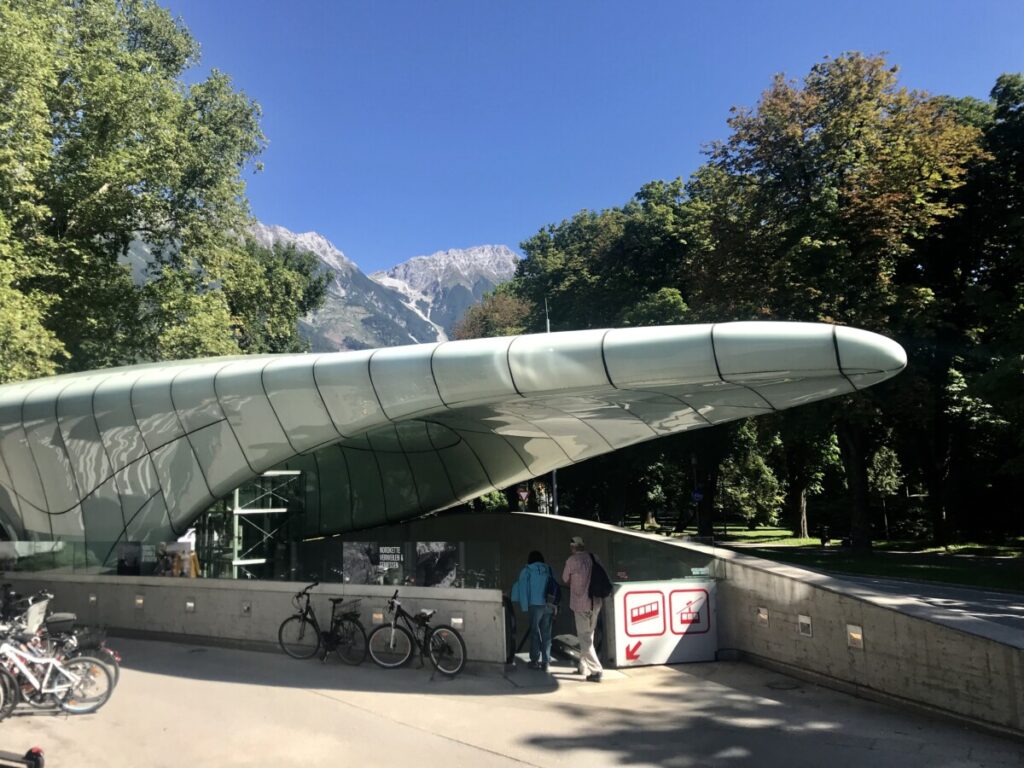
Darum geht es hier:
The Hungerburgbahn Funicular in Innsbruck
The Hungerburgbahn funicular is one of the attractions in Innsbruck and at the same time the public transportation system connecting the city center of Innsbruck to the Hungerburg district. On the way from downtown to the mountain, there are stops at Löwenhaus (where the old valley station was located) and the station near Alpenzoo. The terminus of the Hungerburgbahn in Innsbruck is the mountain station on the Hungerburg at Hermann Buhl Platz.
The Hungerburgbahn is a modern funicular in the Tyrolean capital, serving as an important link between the city center and the picturesque Hungerburg for both locals and tourists. Its features encompass several aspects:
- Innovative Design: The Hungerburgbahn stands out for its impressive and innovative design, conceived by the renowned architect Zaha Hadid. The stations along the route are architectural masterpieces contributing to the attractiveness of the line.
- Route: The railway follows a curved path from downtown Innsbruck to the Hungerburg on the mountainside north of the Inn River. The carefully designed route ensures a smooth and pleasant ride, providing breathtaking views of the city and the surrounding mountain landscape.
- Technical Features: The Hungerburgbahn is a funicular railway that overcomes an elevation difference of 288 meters. Its vehicles are equipped with an incline system, adjusting the longitudinal tilt of the passenger compartments according to the section of the track. This feature allows passengers to comfortably stand and board on both horizontal sections and slopes.
- Tourist Attraction: The railway is not just a practical means of transportation but also a significant tourist attraction. It offers visitors a unique perspective of Innsbruck and the surrounding mountains. The views from the stations and during the ride are spectacular, making the Hungerburgbahn a popular destination for tourists.
- Urban and Natural Connection: The Hungerburgbahn links the vibrant downtown of Innsbruck to the serene and scenic surroundings of Hungerburg. This connection allows passengers to access nature quickly from the urban bustle and appreciate the region’s diversity.
- Combination of Old and New: While the Hungerburgbahn represents modern transportation, it references the past, especially the old Hungerburgbahn from 1906. The rail route partially follows the path of the old railway, connecting traditional history with contemporary mobility.
Hungerburgbahn Valley Station
To facilitate access to the Hungerburg from Innsbruck, the Hungerburgbahn, opened in 2007, was built closer to the city center. The Hungerburgbahn now starts directly at Congress Innsbruck. Visitors can walk from their hotel in Innsbruck’s Old Town to the Hungerburgbahn valley station and start their trip with the Nordkette cable car. Take a moment to admire the distinctive architecture of the valley station, designed by the globally renowned architect Zaha Hadid. The stations at Löwenhaus, Alpenzoo, and the Hungerburg also reflect her design. This exceptional architecture attracts thousands of visitors specifically to the Hungerburgbahn valley station.
Hungerburgbahn Innsbruck: combination of mountain railway and metro
The Hungerburgbahn operates as both a mountain railway and a metro system. Passengers start underground in the city center, ascend at Löwenhaus, and then continue upward on the mountain. This unique system involves two trains running simultaneously. As one train starts from the bottom, the other departs from the top. They are connected by cables, where the upper train pulls the lower one up a section of the track.
The Hungerburgbahn departing from Congress begins like a metro and runs on tracks across the Inn River, transitioning to a funicular railway towards the Karwendel mountains of Innsbruck. Due to steep inclines, the train compartments tilt according to the terrain. It’s an intricate engineering feat, so pay attention during the ride.
This technology also allows the train to stop at Alpenzoo. To facilitate passenger exits at this steep location, the Alpenzoo station is equipped with stairs and an elevator. Concerning elevation from Innsbruck, the Alpenzoo station is approximately 750 meters above sea level. This makes it an essential intermediate station on the way to the Hungerburg, which sits at around 860 meters. Just before the Alpenzoo station, the train passes through a tunnel.
Innsbruck’s Viewing Points
The journey on the Hungerburgbahn also takes passengers to some fantastic viewing points in Innsbruck. As you exit the tunnels and ascend towards Karwendel, the panorama opens up, revealing views of Serles and Kalkkögel. At Hungerburg, the panoramic view includes Innsbruck from the „Hermann Buhl Platz.“ This square is at the mountain station of the Innsbruck mountain railway. Hermann Buhl was an Innsbruck native who not only climbed many peaks in the Karwendel but was also the first to conquer Nanga Parbat. Enjoy the stunning views of Innsbruck!
From Hungerburgbahn Innsbruck to Seegrube and Hafelekar
At Hermann Buhl Platz, signs indicate a 1-minute walk to Seegrubenbahn. Before heading there, take a moment to enjoy the view and explore the architecture of this station. The view and architecture make this area one of the attractions in Innsbruck. At the mountain station of the Hungerburgbahn, you can board the Seegrubenbahn. It takes you further up into the Karwendel, towards the „Top of Innsbruck“ at Hafelekar. Before reaching Hafelekar, you’ll arrive at Seegrube. Enjoy the view from the glass-bottom gondola on your way to Seegrube.
Hungerburgbahn Funicular Ticket
You can purchase Hungerburgbahn funicular tickets at the valley station. There is a ticket counter open from 8 AM to 6 PM. Tip: If you know in advance that you’ll need a Hungerburgbahn ticket, buy it online to avoid waiting in line at the counter. Another tip: Travel all the way to the top at Hafelekar for the most breathtaking view, including the Karwendel. Definitely worth seeing; you even get 10% off with my discount code!
–> Hafelekar ticket
FAQs about Hungerburgbahn funicular
The Hungerburgbahn is a funicular railway and a hybrid metro system in Innsbruck, Austria. It serves as both a public transport system and a tourist attraction, connecting the city center of Innsbruck with the district of Hungerburg. The railway line connects several key locations, including stops at Löwenhaus, Alpenzoo, and the final stop at the Bergstation (mountain station) situated on Hungerburg at Hermann Buhl Platz.
Here are some key features and aspects of the Hungerburgbahn:
Innovative Design: The Hungerburgbahn is renowned for its impressive and contemporary design, created by the renowned architect Zaha Hadid. The stations along the railway line are architectural marvels, contributing to the visual appeal of the route.
Route: The railway follows a curved path from downtown Innsbruck to Hungerburg on the northern slope of the Inn River. The route is carefully designed to ensure a smooth and pleasant ride while offering breathtaking views of the city and the surrounding mountain landscape.
Technical Details: As a funicular railway, the Hungerburgbahn overcomes a height difference of 288 meters. The train cars are equipped with a tilting mechanism, allowing adjustments to the longitudinal inclination of the passenger compartments based on different sections of the track. This feature enables passengers to stand comfortably both on flat surfaces and inclines.
Tourist Attraction: Besides being a functional mode of transportation, the Hungerburgbahn is a significant tourist attraction. It provides visitors with a unique perspective of Innsbruck and the nearby mountains. The scenic views from the stations and during the ride make the Hungerburgbahn a popular destination for tourists.
Connection between City and Nature: The railway links the vibrant downtown area of Innsbruck with the peaceful and picturesque surroundings of Hungerburg. This connection allows passengers to transition quickly from urban life to natural landscapes and appreciate the diversity of the region.
Combination of Old and New: While the Hungerburgbahn represents modern transportation, it also pays homage to the past, particularly the old Hungerburgbahn built in 1906. Parts of the current track utilize the original railway line, creating a connection between traditional history and contemporary mobility.
The Hungerburgbahn offers not just a means of travel but also an experience, showcasing the city’s innovative architecture, engineering, and providing passengers with scenic views of Innsbruck and its environs.
To get to the Hungerburgbahn in Innsbruck, you can follow these steps:
From Innsbruck’s City Center: The Hungerburgbahn is easily accessible from the city center of Innsbruck. You can walk from the city center to the Hungerburgbahn’s lower station, located near the Congress Innsbruck.
Public Transport: Innsbruck has an efficient public transportation system. You can use trams or buses that run within the city to reach the Hungerburgbahn. Several tram and bus lines connect different parts of Innsbruck to the Hungerburgbahn’s lower station.
By Car: If you’re driving, you can use the parking facilities near the lower station. The Congress Innsbruck parking garage is a convenient place to park if you’re planning to take the Hungerburgbahn. Additionally, if you purchase a Nordkettenbahn ticket for the Hafelekar, you might have the option to park cheaper. However, please check the parking details as they may vary.
Google Maps: Using this map of Google or other navigation apps can provide you with specific directions based on your current location in Innsbruck.
The Hungerburgbahn funicular in Innsbruck was designed by the renowned Iraqi-British architect Zaha Hadid. Hadid, known for her groundbreaking architectural designs, was responsible for the impressive and innovative design of the stations along the Hungerburgbahn railway line. Her architectural vision and unique style contributed significantly to the visual appeal and modernity of the Hungerburgbahn’s infrastructure.
Additional Links
- explore the Golden Roof
- don´t miss the Christmas market
- auf deutsch über die Hungerburgbahn

